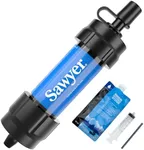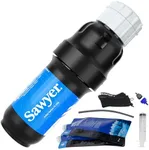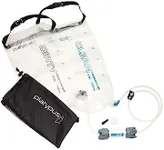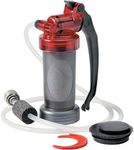Buying Guide for the Best Hiking Water Filters
Choosing the right hiking water filter is crucial for ensuring you have access to clean and safe drinking water during your outdoor adventures. The right filter can protect you from harmful bacteria, protozoa, and other contaminants found in natural water sources. When selecting a hiking water filter, consider the following key specifications to find the best fit for your needs.Filter TypeThe filter type determines how the water is purified. Common types include pump filters, gravity filters, squeeze filters, and straw filters. Pump filters are versatile and can filter large amounts of water quickly, making them suitable for groups. Gravity filters are great for base camps as they require minimal effort. Squeeze filters are lightweight and ideal for solo hikers. Straw filters are compact and best for emergency use. Choose a filter type based on your hiking style and the number of people in your group.
Filter Pore SizeFilter pore size indicates the size of the particles the filter can remove. Measured in microns, smaller pore sizes can filter out more contaminants. A pore size of 0.2 microns is effective against bacteria and protozoa, while a 0.1-micron filter offers even better protection. For most hiking scenarios, a 0.2-micron filter is sufficient, but if you are hiking in areas with known contamination issues, opt for a 0.1-micron filter.
Flow RateFlow rate measures how quickly water passes through the filter, usually in liters per minute. A higher flow rate means you can filter water faster, which is beneficial when you need to hydrate quickly or filter water for multiple people. Flow rates can vary from 0.5 liters per minute to over 2 liters per minute. If you are hiking solo, a lower flow rate may be acceptable, but for groups, a higher flow rate is more practical.
Weight and PortabilityWeight and portability are important considerations, especially for long hikes or backpacking trips. Lightweight filters, typically under 200 grams, are ideal for solo hikers or those who prioritize minimal gear. Heavier filters may offer more features or higher capacity, making them suitable for group hikes or base camps. Consider how much weight you are willing to carry and balance it with the filter's capabilities.
Filter LifespanFilter lifespan refers to the amount of water a filter can purify before it needs replacement. This is usually measured in liters. Some filters can last for 1,000 liters or more, while others may need replacement after 100 liters. If you hike frequently or on long trips, a filter with a longer lifespan is more cost-effective and convenient. For occasional hikers, a shorter lifespan may be sufficient.
Ease of UseEase of use encompasses how simple the filter is to set up, operate, and maintain. Some filters require pumping or squeezing, while others rely on gravity or direct drinking. Consider how much effort you are willing to put into filtering water. Additionally, look for filters that are easy to clean and maintain, as this will ensure they remain effective over time. Choose a filter that matches your comfort level and physical capabilities.
Additional FeaturesSome water filters come with additional features such as integrated water bottles, compatibility with hydration bladders, or the ability to filter viruses. These features can add convenience and versatility to your hiking experience. Consider what extra features might be beneficial for your specific needs. For example, if you use a hydration bladder, a filter that integrates with it can save time and effort.















